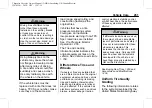
Chevrolet Corvette Owner Manual (GMNA-Localizing-U.S./Canada/Mexico-
12470550) - 2020 - CRC - 12/17/19
Vehicle Care
249
(6) Uniform Tire Quality
Grading (UTQG)
:
Tire
manufacturers are required to
grade tires based on three
performance factors: treadwear,
traction, and temperature
resistance. For more information
see
(7) Maximum Cold Inflation
Load Limit
:
Maximum load that
can be carried and the
maximum pressure needed to
support that load.
Tire Designations
Tire Size
The example shows a typical
passenger vehicle tire size.
(1) Passenger (P-Metric) Tire
:
The United States version of a
metric tire sizing system. The
letter
“
P
”
as the first character in
the tire size means a passenger
vehicle tire engineered to
standards set by the U.S. Tire
and Rim Association.
(2) Tire Width
:
The three-digit
number indicates the tire section
width in millimeters from
sidewall to sidewall.
(3) Aspect Ratio
:
A two-digit
number that indicates the tire
height-to-width measurements.
For example, if the tire size
aspect ratio is 60, as shown in
item (3) of the illustration, it
would mean that the tire's
sidewall is 60 percent as high as
it is wide.
(4) Construction Code
:
A letter
code is used to indicate the type
of ply construction in the tire.
The letter
“
R
”
means radial ply
construction; the letter
“
D
”
means diagonal or bias ply
construction.
(5) Rim Diameter
:
Diameter of
the wheel in inches.
(6) Service Description
:
These
characters represent the load
index and speed rating of the
tire. The load index represents
the load carrying capacity a tire
is certified to carry. The speed
rating is the maximum speed a
tire is certified to carry a load.
Tire Terminology and
Definitions
Air Pressure
:
The amount of
air inside the tire pressing
outward on each square inch of
the tire. Air pressure is
expressed in kPa (kilopascal)
or psi (pounds per square inch).
Accessory Weight
:
The
combined weight of optional
accessories. Some examples of
















































